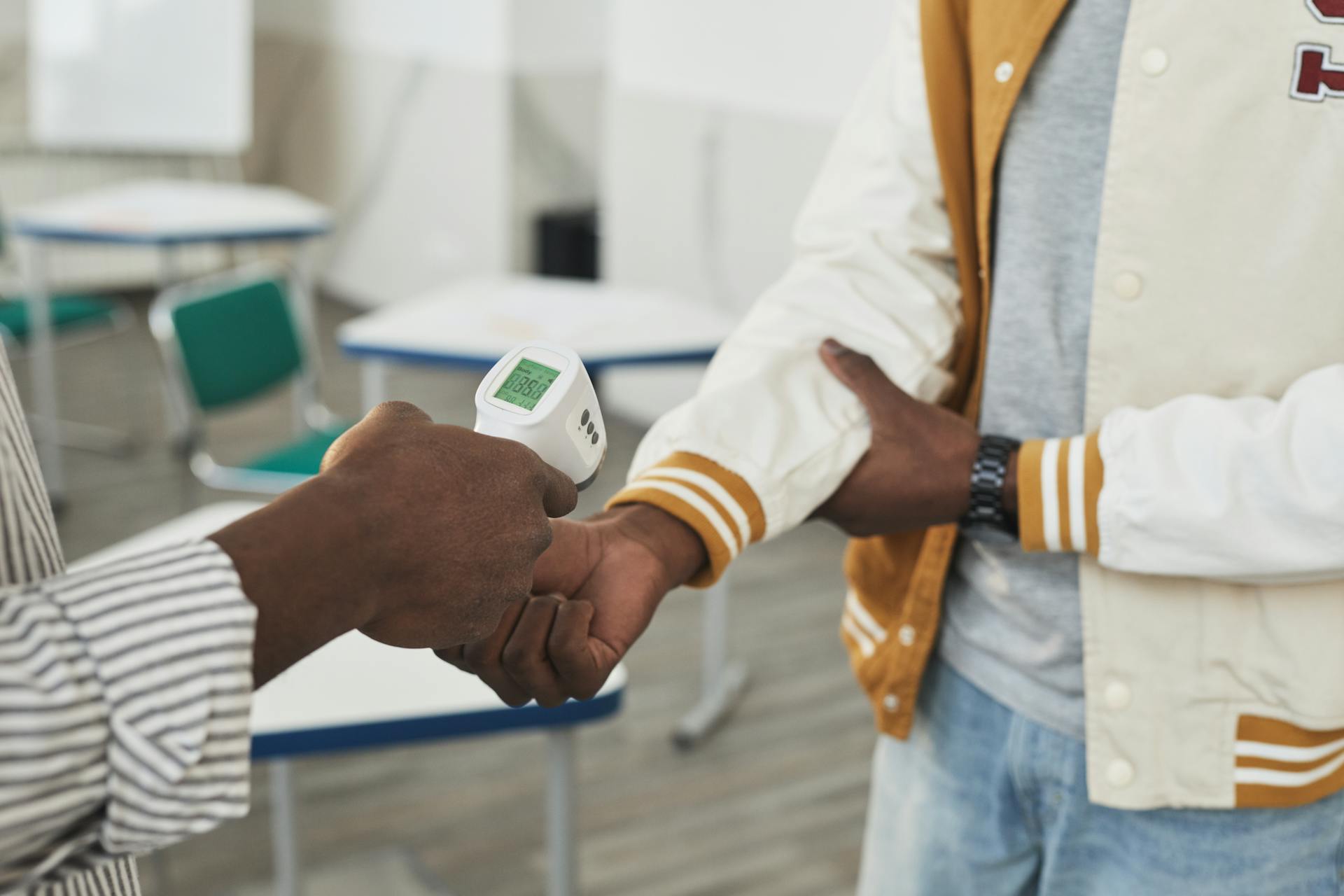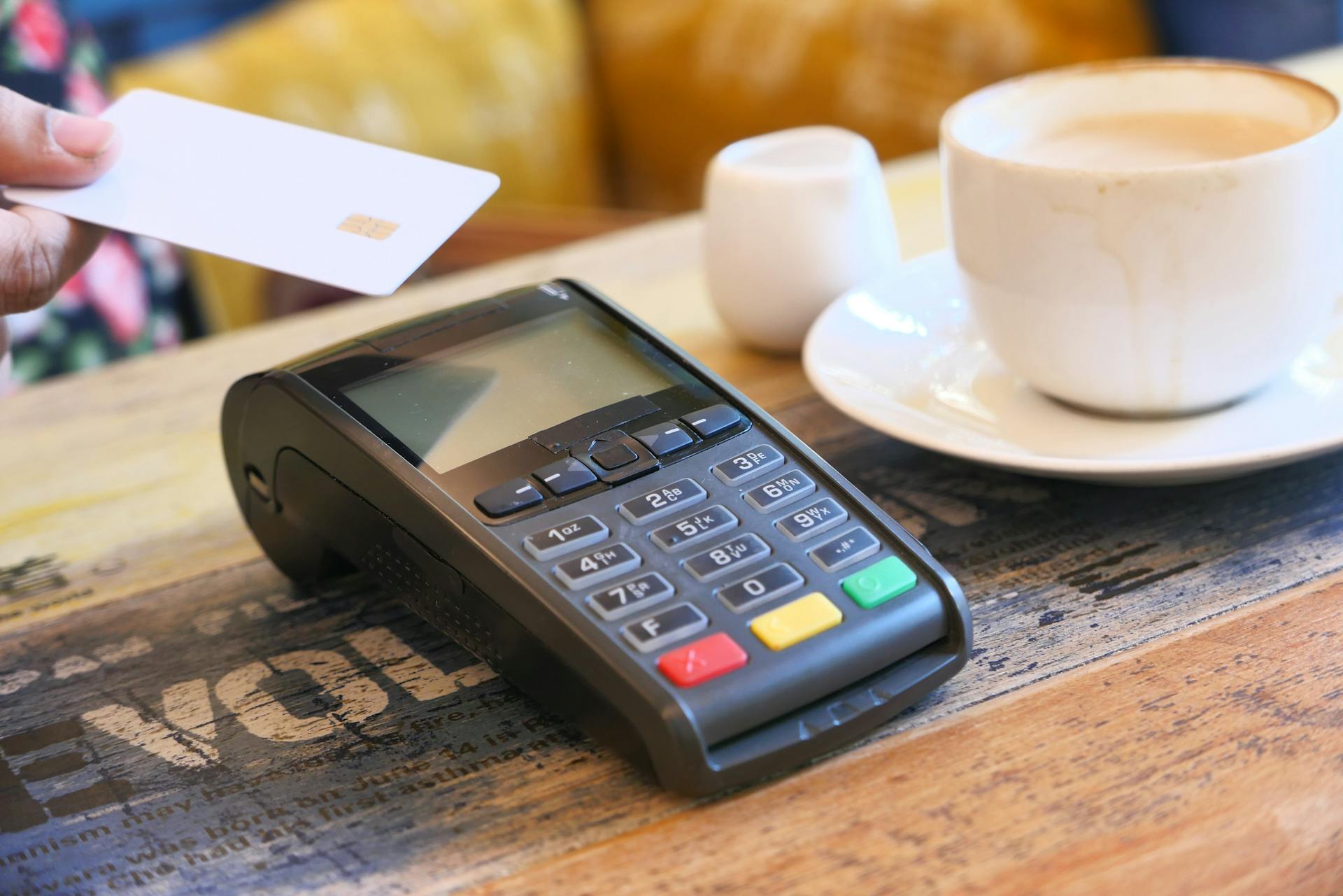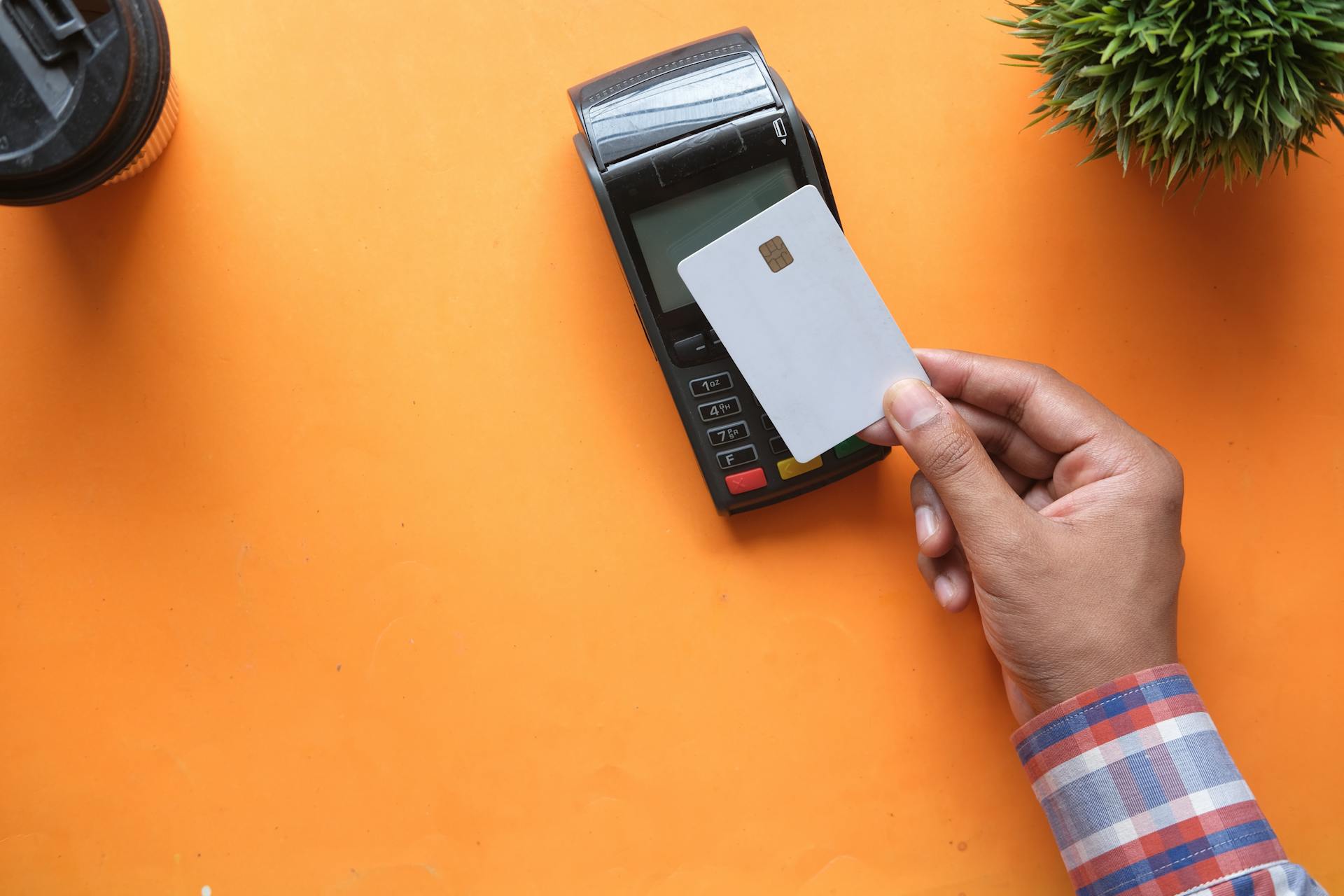
Contactless credit cards have been gaining popularity in recent years, and it's not hard to see why. By 2020, 75% of credit card transactions in the UK were contactless, making it a convenient and secure way to make purchases.
The adoption of contactless credit cards can be attributed to their ease of use. With contactless payments, users can simply tap their card on a payment terminal to make a purchase, eliminating the need to insert their card or enter a PIN.
This convenience has led to a significant increase in contactless transactions. According to a survey, 62% of consumers prefer contactless payments due to their speed and convenience.
As contactless technology continues to advance, we can expect to see even more widespread adoption. In fact, it's predicted that by 2025, 80% of all credit card transactions will be contactless.
Take a look at this: Do S Corps Pay Corporate Taxes
History of Contactless Credit Cards
The history of contactless credit cards is a fascinating story of innovation and adoption. In the late 1990s, Mobil was one of the first companies to introduce a contactless payment system called Speedpass.

In 2002, Philips and Sony teamed up to develop the NFC standard, which would become the foundation for future contactless transactions. Philips Semiconductors then applied for the fundamental patents of NFC, invented by Austrian and French engineers Franz Amtmann and Philippe Maugars.
The first contactless deferred payment experiment was conducted in Germany in 2005, using Nokia 3220 phones on the tramways and bus of Hanau. This was followed by the first immediate contactless payment experiment in France in October 2005, with a Samsung NFC smartphone by Orange in collaboration with Philips Semiconductors.
The first contactless cards in the UK were issued by Barclaycard in September 2007, marking a significant milestone in the adoption of contactless technology.
A different take: Nfc Tap to Pay
1990s-2000s
In the 1990s and early 2000s, contactless technology started to gain traction. Mobil was one of the first companies to adopt this technology, introducing their "Speedpass" contactless payment system in 1997.
This service allowed customers to pay for gas at participating Mobil stations without needing to insert a card or use a cash register. Although Mobil has since merged with Exxon, the service is still offered at many ExxonMobil stations.
Expand your knowledge: Emv Technology Credit Cards
In 2002, Philips and Sony teamed up to develop the NFC standard, which would become a key technology in contactless payments. Philips Semiconductors also applied for the six fundamental patents of NFC, invented by Austrian and French engineers Franz Amtmann and Philippe Maugars.
The first contactless payment systems were tested in various locations around the world, including Germany, France, and the UK. In May 2005, a contactless deferred payment system was experimented with in Germany on the tramways and bus of Hanau using the Nokia 3220 phone.
In October 2005, the first immediate contactless payment was experimented with in France in Caen, using a Samsung NFC smartphone provided by Orange. This system allowed customers to receive audiovisual information, such as bus timetables or cinema trailers, in addition to making payments.
The first contactless cards in the UK were issued by Barclaycard in September 2007. PayPass also trialed the world's first NFC-enabled phone, the Nokia 6131 NFC, in New York in 2007.
Worth a look: Earn Money from Mobile Phone
The 2010s
The 2010s saw a significant shift in the adoption of contactless credit cards. In 2011, Visa introduced its payWave technology, which allowed for contactless payments using a special chip in the card.
Contactless payments started to gain traction, with many merchants adopting the technology. In 2012, the UK became the first country to introduce contactless payments on public transportation, with Transport for London (TfL) launching the Oyster card.
By 2013, contactless payments had become more widespread, with many major retailers in the UK and other countries adopting the technology. The rise of contactless payments was largely driven by the convenience and speed it offered to consumers.
The introduction of the Apple Pay mobile payment system in 2014 further accelerated the adoption of contactless payments. Apple Pay allowed users to make payments using their iPhone, watch, or iPad, making it even easier to make contactless transactions.
In 2015, the UK government announced plans to phase out traditional chip and PIN payments in favor of contactless payments. This move was seen as a major step towards a cashless society.
The 2010s were a transformative time for contactless credit cards, with significant advancements in technology and widespread adoption by merchants and consumers.
A fresh viewpoint: Apple Tap to Pay Ripple
Adoption and Usage
Contactless credit card adoption has been steadily increasing over the years, with a significant rise in the number of contactless-enabled cards and terminals in use. As of 2014, there were approximately 58 million contactless-enabled cards in use in the UK, and over 147,000 terminals in use.
The ease of small transactions has led to an increase in consumer spending, with Mastercard Canada reporting about 25 percent higher spending by users of its Mastercard Contactless-brand RFID credit cards. In the UK, contactless payments surpassed cash transactions by June 2017, accounting for approximately one third of all card transactions.
In Australia, contactless payments approached saturation point in 2017, with over 90% of purchases made using this method, according to the Westpac Banking Corporation. Similarly, the Australian St.George Bank reported 94.6% usage for the same period.
Related reading: Amex Platinum Card Uk
The 2020s
The 2020s saw significant changes in contactless payment adoption.
In the United Kingdom, the contactless payment limit was raised from £30 to £45 in March 2020, and later to £100.
Contactless payments were recommended as a safer payment method compared to Chip and PIN card payments and cash transactions during the COVID-19 pandemic.
Apple Inc. announced Tap to Pay in 2022, a feature that allows merchants to use iPhone devices as payment terminals for contactless cards.
Adoption and Usage
Contactless payments have become increasingly popular, with more and more people using them to make purchases.
By 2017, purchases made by card surpassed those made by cash in the UK, and contactless payments accounted for approximately one third of all card transactions.
The number of contactless-enabled cards in use in the UK reached 58 million by December 2014, and over 147,000 terminals were in use.
Contactless payments made up around 19% of transactions in the UK by 2018.
In Australia, contactless payments approached saturation point by 2017, with over 90% of purchases made using this method.
The Westpac Banking Corporation reported that contactless payments were used in 94.6% of purchases in Australia during the same period.
Major financial entities, such as Mastercard, China UnionPay, and American Express, now offer contactless payment systems.
Visa estimates that there will be 300 million contactless cards issued in the US by the end of 2020.
Telecom operators, like Belgacom, are also getting involved in contactless payments by using NFC-enabled phones.
Contactless payment limits have been raised during the COVID-19 pandemic, with the UK limit increasing from £30 to £100.
Intriguing read: British Credit Cards
Mobile Payment Power
Mobile payment power is on the rise, and it's easy to see why. Google Pay, for example, is an application for devices running Google's Android OS, which allows users to make purchases using NFC.
As of 2018, contactless payments made up around 19% of transactions in the UK. The number of payments by this method had increased significantly since the spending limit was raised from £20 to £30.
In Australia, contactless payments approached saturation point by being used in over 90% of purchases, according to the Westpac Banking Corporation. The Australian St.George Bank reported 94.6% usage for the same period.
Visa estimates there will be 300 million contactless cards issued in the US by the end of 2020, up from the predicted 100 million at the end of 2019. This is a significant increase, and it's likely that contactless payments will become even more widespread in the US.
Telecom operators are starting to get involved in contactless payments via the use of NFC-enabled phones. Belgacom's Pingping, for example, has a stored value account and via a partnership with Alcatel-Lucent's Touchatag provides contactless payment functionalities.
Contactless payment technology is also used on major transit systems in parts of the U.S. and worldwide. For example, the New York City Metropolitan Transit Authority has used the technology for years and will expand to include the AirTrain JFK, which connects subway riders to JFK Airport.
Curious to learn more? Check out: Nfc Credit Cards
Technology and Security
Contactless credit cards use a smart chip or cryptographic chip, known as a smart card, which allows wireless payments to be made using RFID technology. This chip is placed on the card and authenticates the card issuer's details through a series of PIN interactions.
The EMV standard is adopted throughout payment terminals, which enables contactless payments to be made. Typically, the optimum distance for NFC technology in contactless cards is 4 centimeters or less.
Contactless cards use a 13.56Mhz radio frequency technology that only transmits digital data within a concise range, reducing the risk of data theft. This is especially important during transactions, as the signal rapidly decreases beyond 4 centimeters and can never exceed 10 centimeters.
Additional reading: Technology behind Credit Cards
Security
Contactless cards offer a level of security that's on par with chip cards, which require you to insert your card into the reader.
The chip on your contactless card encrypts your account information, making it difficult for hackers to steal your data.
In 2006, security researchers found that contactless payment cards could transmit sensitive information without encryption, but modern contactless cards have improved security measures.
Contactless transactions use a unique token each time you make a purchase, rather than transmitting your actual credit card number, name, and security code.
You can still use your contactless card like a traditional chip card, inserting it into the reader if you prefer, and you'll always have the option to do so.
The embedded EMV chip on your contactless card encrypts your account information, and if you pay with your smartphone, the card stored in your mobile wallet is tokenized, replacing your actual account number with a random number.
Contactless transactions with your phone are secured by biometrics like fingerprint or Face ID, and cryptograms that generate a one-time code for every transaction.
Under fraud guarantee standards, U.S. banks are liable for any fraudulent transactions charged to your contactless card.
Consider reading: Paynow Real Time Payments
Technology
Contactless payments use a smart chip or cryptographic chip on the card, allowing wireless payments to be made from the EMV chip in range of a payment terminal using RFID technology.
The EMV standard is adopted throughout payment terminals, and it authenticates the card issuer's details through a series of PIN interactions.
Tokenisation is a newer approach to smart card technology, achieved by linking a smart card to a hardware device, such as an iPhone, using a token generated by the card issuer.
A Device Account Number (DAN) is generated along with a private key and sent to the card issuer during initial setup of the smart card on the hardware device.
Contactless cards use near field communication (NFC) technology, which operates at a frequency of 13.56Mhz and transmits digital data within a concise range.
Typically, the optimum distance for NFC technology is 4 centimeters or less, and the signal rapidly decreases beyond this range.
Suggestion: Emv Chip and Pin Credit Cards

Contactless cards have a microchip and antenna that allow them to communicate wirelessly with a merchant terminal via short-range radio frequency, known as near field communications (NFC).
To make a contactless card purchase, you need a debit, credit, or smart card equipped with contactless technology, and a merchant point-of-sale terminal able to accept contactless payments.
Contactless cards look like regular cards, but they have a microchip and antenna that enable wireless payments.
Recommended read: Merchant Bank Id Credit Card Authorization
Payment Limit
Being aware of your payment limit is crucial to avoid errors when making transactions.
The contactless payment limit varies depending on your account type.
If you have an N26 Standard account, you'll need to be mindful of this limit when making payments.
For N26 Smart users, the monthly fee is €9.90.
A fresh viewpoint: N26
Frequently Asked Questions
What are the disadvantages of contactless credit cards?
Contactless credit cards may have transaction limits and can accidentally charge you if you're near a payment terminal or multiple cards are in close proximity.
What is a contactless-enabled credit card?
A contactless-enabled credit card is a type of credit card that uses contactless technology, allowing for quick and secure transactions without physically inserting the card into a reader. However, you may still be asked to enter your PIN for certain transactions or security checks.
How do I know if I have a contactless credit card?
Look for a wave-like symbol on the front of your card, similar to a Wi-Fi symbol, to see if it's contactless enabled. This symbol indicates you can make tap-to-pay transactions with participating retailers.
Is contactless safer than chip?
Contactless payments are generally safer than chip cards because the card itself doesn't make contact with the terminal, reducing the risk of card skimming or tampering. However, the safety of contactless payments also depends on the card's EMV chip technology.
How does a contactless credit card work?
Contactless credit cards use RFID technology to transmit information wirelessly to a card reader when held near it. This allows for fast and secure payments without the need for physical contact.
Sources
- https://en.wikipedia.org/wiki/Contactless_payment
- https://newsroom.mastercard.com/news/perspectives/2024/contactless-101-what-you-need-to-know-about-tap-and-go/
- https://n26.com/en-eu/contactless-card
- https://www.discover.com/credit-cards/card-smarts/what-do-you-know-about-contactless-credit-cards/
- https://www.citizensbank.com/learning/what-are-contactless-cards.aspx
Featured Images: pexels.com


